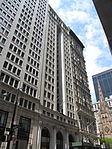Rector Street station (BMT Broadway Line)
1918 establishments in New York CityBMT Broadway Line stationsFinancial District, ManhattanFuture accessible New York City Subway stationsNew York City Subway stations in Manhattan ... and 3 more
New York City Subway stations located undergroundRailway stations in the United States opened in 1918Use mdy dates from June 2017

The Rector Street station is a local station on the BMT Broadway Line of the New York City Subway. Located at the corner of Rector Street and Trinity Place in Financial District, Lower Manhattan, the station is served by the R train at all times except late nights, when the N train takes over service. The W train also serves this station on weekdays.
Excerpt from the Wikipedia article Rector Street station (BMT Broadway Line) (License: CC BY-SA 3.0, Authors, Images).Rector Street station (BMT Broadway Line)
Trinity Place, New York Manhattan
Geographical coordinates (GPS) Address External links Nearby Places Show on map
Geographical coordinates (GPS)
| Latitude | Longitude |
|---|---|
| N 40.70771 ° | E -74.013004 ° |
Address
Rector Street
Trinity Place
10006 New York, Manhattan
New York, United States
Open on Google Maps







